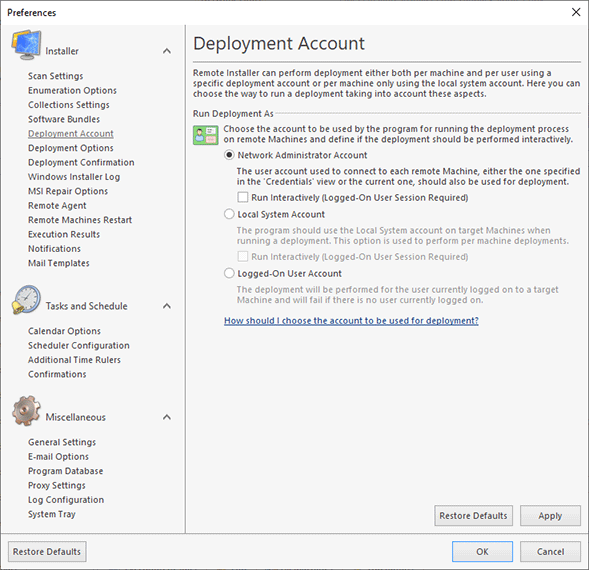How should I choose the account to be used for deployment?
Remote Installer allows you to choose the account to be used for deployments, both by default and for particular deployments, and specify if the deployment should be performed interactively. The configuration is available via deployment account settings. Let us take a closer look at each of the available options and the cases they should be used in.
Let us start with the Network Administrator Account option. When this option is active, Remote Installer executes deployments on target computers from the same user account as used to connect to a remote Machine. This option is suitable for the vast majority of deployments, thus is recommended for Preferences. You can perform a deployment using the network administrator account both in non-interactive and interactive sessions. Interactive deployment should be used if silent deployment is not supported, so the user input is required to complete the deployment. The same goal can be reached using the Logged-On User Account option. The only difference is that the network administrator mode allows you to run deployments that require administrative rights that logged-on users may not have. When running a deployment interactively as the deploying user, you should make sure that explicit network administrator credentials are specified. This ensures access to the desktop of the currently logged-on user starting from Windows Vista, as it is not possible to grant such an access to the account used for an implicit network logon. The administrative credentials for accessing remote Machines are provided in the Credentials view.
As for the Local System Account option, it should only be used if excessive permissions are required to perform a per-machine deployment. This type of deployment is very rare. For this option, you can also enable interactive deployment to run the process in a session of the currently logged-on user, if an unattended setup is not supported.
The Logged-On User Account option commands Remote Installer to run a deployment interactively as the user currently logged on to a remote Machine. The deployment process will proceed in the same way as if the user had simply launched the installation setup program by himself. This option is used to deploy applications that are installed per user or when the logged-on user needs to provide information for the deployment to succeed. Such types of deployment are highly specialized.
Now that you are familiar with the options available for running remote deployments as different types of users and the use cases for those options, you should be able to choose the best one for reaching your specific goals.
